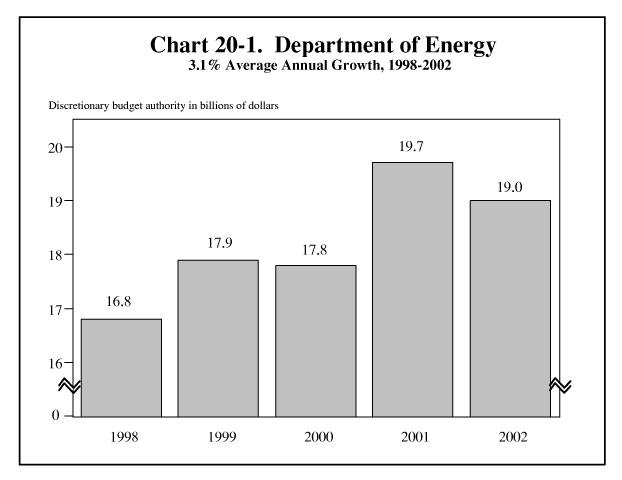
- Afghanistan
- Africa
- Budget Management
- Defense
- Economy
- Education
- Energy
- Environment
- Global Diplomacy
- Health Care
- Homeland Security
- Immigration
- International Trade
- Iraq
- Judicial Nominations
- Middle East
- National Security
- Veterans
|
Home >
News & Policies
|
20. Department of Energy
|
Initiatives
Increase Weatherization Assistance Funding: The President proposes to increase funding for the low-income home Weatherization Assistance Program (WAP) by $1.4 billion over 10 years, roughly doubling the spending during that period. Consistent with that commitment, the 2002 Budget will include a $120 million increase over 2001. The Department of Energy (DOE) will have the option of using a portion of those funds to test improved implementation approaches for the Weatherization program.

Restructure the Clean Coal Research Program: Using a consortium of companies to direct research funds to address broad industry issues, a restructured "clean coal" research program will spend more than $2 billion over 10 years for technology and efficiency improvements to reduce the environmental impact of the use of coal. All projects will require cost sharing by participants, with the industry share increasing as products approach commercialization.
Strengthen Stockpile Stewardship: The Stockpile Stewardship Program maintains our nuclear arsenal. The program is an essential safeguard to our national security and is in significant need of reform and repair. The budget increases funding for activities in this area by five percent to approximately $5.3 billion.
Strengthen Solar and Renewable Energy Technology Research and Development (R&D): As part of the Administration's plan to allow oil and gas drilling in a small part of the Arctic National Wildlife Refuge (ANWR) and other Federal lands, bonuses paid by winning ANWR bidders, up to $1.2 billion, will be set aside to help fund enhanced research on alternative energy technologies. Bidding bonuses are estimated to be received in 2004.
Give Tax Credits for Renewable Energy and Nuclear Decommissioning: To further boost incentives for private sector development and use of renewable energy, the Administration will propose to extend and increase tax credits for fuel produced from renewable resources, as well as a tax credit for rooftop solar energy equipment. In addition, the Administration will propose to modify the tax treatment of nuclear decommissioning costs.
Maintain Northeast Heating Oil Reserve: The President's Budget provides $8 million to maintain the two-million-barrel Northeast Heating Oil Reserve. Operated by the private sector, the Reserve helps ensure adequate supplies of heating oil in the event that colder than normal winters occur in the Northeastern United States.
Redirected Resources
DOE's 2001 enacted funding level included significant earmarks or directed-spending initiatives that were not assessed as part of a merit-based or peer reviewed process. These projects and programs often address lower priority issues or are not of national interest. The budget does not fund these initiatives.
The Department faces major challenges in the management of its programs. According to historical data evaluated by the General Accounting Office, less than 10 percent of major programs initiated by DOE are completed on time and on budget. Almost 40 percent of such projects are never even completed. These projects extend from environmental remediation to research and development.
Management in general, and contract management in particular, have consistently been listed by the General Accounting Office as high risk activities. Project and contract management have also been listed by the Inspector General as top management challenges. DOE intends to achieve significant savings in 2002 from restructuring and reevaluating the performance of major projects across the Department including environmental management and science projects. In addition, research and development projects that subsidize large companies will be suspended or revisited to determine the appropriate role of the Department and private sector.
Potential Reforms
Reform Procurement and Contracting: Many of DOE's contract reform goals set out in 1994 have still not been achieved. DOE will continue efforts to improve its procurement systems, through which it allocates over 85 percent of its annual budget. DOE will adopt best commercial practices and increase performance-based competitive contracting.
Implement More Consistent and Aggressive Cost-Sharing Requirements for Applied R&D: DOE's applied R&D programs frequently require industry cost sharing, but the requirements vary widely from program to program. Subsidies to industry average 50 percent and exemptions are common. Federal R&D funds could be better leveraged and R&D projects would stay more focused on real market needs if the level and consistency of cost-sharing requirements were increased, based on an existing successful model developed for advanced automotive R&D.


